Sandwich, Kent
Sandwich is a historic town and civil parish in the Dover District of Kent, south-east England. It lies on the River Stour and has a population of 4,985.[1] Sandwich was one of the Cinque Ports and still has many original medieval buildings, including several listed public houses and gates in the old town walls, churches, almshouses and the White Mill. While once a major port, it is now two miles from the sea due to the disappearance of the Wantsum Channel. Its historic centre has been preserved.[2] Sandwich Bay is home to nature reserves and two world-class golf courses, Royal St George's and Prince's. The town is also home to many educational and cultural events. Sandwich also gave its name to the food by way of John Montagu, 4th Earl of Sandwich, and the word sandwich is now found in several languages.
| Sandwich | |
|---|---|
 The 14th-century St Thomas' Hospital | |
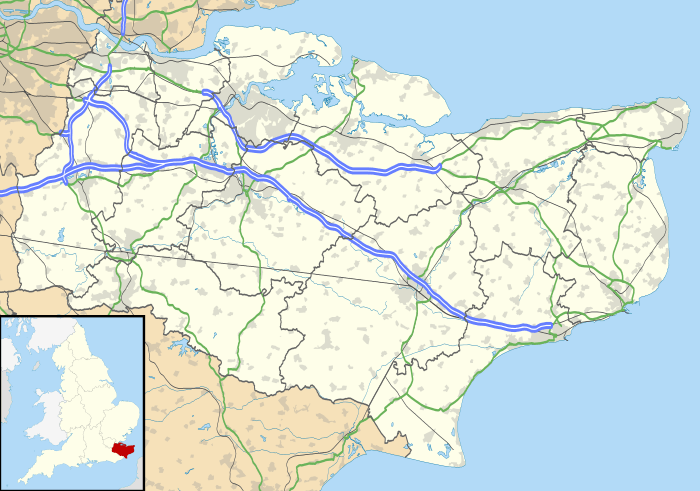 Sandwich Location within Kent | |
| Population | 4,985 (2011)[1] |
| OS grid reference | TR335585 |
| District | |
| Shire county | |
| Region | |
| Country | England |
| Sovereign state | United Kingdom |
| Post town | Sandwich |
| Postcode district | CT13 |
| Dialling code | 01304 |
| Police | Kent |
| Fire | Kent |
| Ambulance | South East Coast |
| UK Parliament | |
Etymology
The place-name 'Sandwich' is first attested in the Anglo-Saxon Chronicle, where it appears as Sondwic in 851 and Sandwic in 993. In the Domesday Book of 1086 it appears as Sandwice. The name -wich comes from the Anglo Saxon -wīc, meaning a dwelling or fortified place where trade takes place. The name means "market town on sandy soil".[3]
History
_-_geograph.org.uk_-_650895.jpg)
Before Sandwich became a Cinque Port, the ancient Saxon town of Stonar on the bank of the Wantsum estuary, but on the opposite side of the mouth of the River Stour, was already well established. It remained a place of considerable importance but it disappeared almost without trace in the 14th century. The ruins of the major Roman fort of Richborough are close by. It was the landing place of the Roman invasion of Britain in AD 43.[4] In 2008, an archaeological dig proved that this was a defensive site of a Roman beachhead, protecting 700 metres of coast.[5]
In 1028 King Canute (c. 995–1035) granted a charter to the monks of Christ Church, Canterbury, to operate a ferry across the river and collect tolls. In 1192, returning from the Third Crusade, Richard the Lionheart was jailed by the Holy Roman Emperor Henry VI. Henry released Richard in February 1194. On 13 March 1194, Richard landed at the port of Sandwich and came back to England.[6] On 21 May 1216, Prince Louis of France landed at Sandwich in support of the First Barons' War against King John.[7] The Battle of Sandwich occurred just off the coast in 1217.
The Port of Sandwich is no stranger to odd events in English history. It was here that the first captive elephant was landed in England by the emperor Claudius.[8] Later another elephant was landed here, in 1255. The prize beast arrived at Sandwich quayside, delivered as a gift to the English monarch Henry III from the French king, and was then taken on foot to the king's menagerie in the Tower of London. The journey through Kent is reported to have proceeded without incident, except when a bull in a field by the roadside took umbrage at the great beast passing and attacked it. In one move, the animal was thrown by the elephant and killed outright.[9]
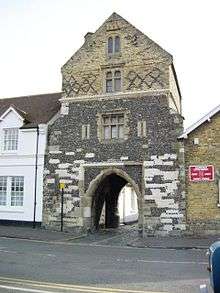
The Fisher Gate on the quay dates from 1384, and has been scheduled as an Ancient Monument. It is the only one of the original mediaeval town gates to survive. It is a Grade I listed building.[10] The nearby Barbican dates from the 14th century and stands at the end of the bridge over the River Stour where it was used as a toll house.[11]
On 28 August 1457, after four years of uneasy peace in England the king presided over a wasting realm, with feudal barons lording it over the population of the north and the west.[12] The French took advantage of the situation by sending a raiding party to Kent, burning much of Sandwich to the ground. A force of around 4,000 men from Honfleur, under the command of Pierre de Brézé, Marshal of France, came ashore to pillage the town, in the process murdering the mayor, John Drury. It thereafter became an established tradition, which survives to this day, that the Mayor of Sandwich wears a black robe in mourning for this ignoble deed.
Sandwich later gained significantly from the skills brought to the town by many Flemish settlers, who were granted the right to settle by letters patent from Elizabeth I, dated 6 July 1561.[13] Sandwich was the only town in England that housed more so-called "strangers" than native Englishmen in the 16th century. Historian Marcel Backhouse estimated there were at least 2,400 Flemish and 500 Walloon exiles living in Sandwich at the time.[14] These settlers brought with them techniques of market gardening, and were responsible for growing the first English celery, which was already and still very popular in Flanders. Elizabeth I granted 25 Flemish families permission to live in Sandwich, and St Peter became the "Stranger's Church" in 1564 when the plague came to the town, in an effort to halt the spread of the disease. The 1661 tower collapse was repaired by the Flemish community, and the distinctive tower reflects their work. The Huguenot refugees also brought over Flemish architectural techniques, that are now as much a part of Kent as the thatched cottage. One can still see the difference between the English (lower section) and Flemish (upper section) of the tower. In addition techniques of silk manufacture were imported, enhancing the Kent cloth industry.
The coat of arms of Sandwich is blazoned Per pale Gules and Azure three demi-Lions passant guardant in pale Or conjoined with as many sterns of demi-Ships Argent;[15] see photo. It is one of the earliest heraldic examples of dimidiation, an early method of combining two different coats of arms: in this case the Royal Arms of England (1198–1340), Gules three lions passant guardant Or langued and armed Azure, and the Arms of the Cinque Ports, Azure three ships Or. The title Earl of Sandwich was created in 1660 for the prominent naval commander Admiral Sir Edward Montagu (1625–72).
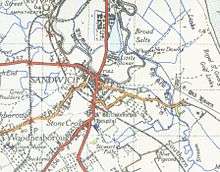
In 1759, Thomas Paine (1737–1809) had his home and shop in a house at 20 New Street.[16] The house is now marked with a plaque and is a listed building.[17]
In 1912 Sir Edwin Lutyens (1869–1944) built The Salutation in Queen Anne style. The gardens were laid out by Gertrude Jekyll.[18] In World War One, Sandwich was important as a transit location for troops heading to Ypres.[19]
In 1980 Jean Barker became, in the full recitation of her life peerage, Baroness Trumpington, of Sandwich in the County of Kent.[20] In 2014 an original copy of Magna Carta, issued in 1300, was found together with a copy of the Charter of the Forest. It was only the second time in history that the two documents have been found together.[21] They are now displayed alongside other historical artefacts in the Sandwich Guildhall Museum.[22]
Governance
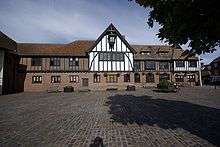
The town and parish council has responsibility for local issues, including setting an annual precept (local rate) to cover the council's operating costs and producing annual accounts for public scrutiny. It comprises sixteen town councillors.[23] The parish council evaluates local planning applications and works with the local police, district council officers, and neighbourhood watch groups on matters of crime, security, and traffic. The parish council's role also includes initiating projects for the maintenance and repair of parish facilities, as well as consulting with the district council on the maintenance, repair, and improvement of highways, drainage, footpaths, public transport, and street cleaning. Conservation matters (including trees and listed buildings) and environmental issues are also the responsibility of the council.
The town falls within the non-metropolitan district of Dover. The district council is responsible for local planning and building control, local roads, council housing, environmental health, markets and fairs, refuse collection and recycling, cemeteries and crematoria, leisure services, parks, and tourism.
Kent County Council is responsible for running the largest and most expensive local services such as education, social services, libraries, main roads, public transport, policing and fire services, trading standards, waste disposal and strategic planning.
It is also part of a county constituency represented in the House of Commons of the Parliament of the United Kingdom, and at the general election in 2010 became part of the South Thanet constituency.[24] It elects one Member of Parliament (MP) by the first past the post system of election.
Geography

There is Monk's Wall nature reserve and a bird observatory at Sandwich Bay, which provides a home for wild duck and other wildlife in a wetland habitat. The reserve was opened by celebrity bird-watcher Bill Oddie in May 2000. Sandwich Bay Bird Observatory Trust proposed the design and a management plan, including modifications to ditches and control of water levels to create ecological conditions that attract wetland species of plants, animals and birds. Historically the land was reclaimed from the river and sea by the monks of Sandwich, and the northern boundary is still the old Monks' wall of the 13th century. In the 1953 floods the sea covered the whole area around Sandwich and after these fields were drained a new river bank was created and the land ploughed for arable farming, with heavy use of fertiliser.[27]
There is also a 15 acres (6 ha) Local Nature Reserve known as Gazen Salts.[28]
Sandwich lies at the southern end of Pegwell Bay, which includes a large nature reserve, known for its migrating waders and wildfowl, with a complete series of seashore habitats including extensive mudflats and salt marsh.
Economy
The local economy has benefited from significant investment by Pfizer UK, the British subsidiary of the multinational pharmaceuticals company Pfizer, which has built a research and development centre near Sandwich, employing over 3,000 people. Laboratory experiments at the site have aroused negative comment by animal rights activists. On 18 June 2007 Pfizer announced it will move the Sandwich Animal Health Research (VMRD) division to Kalamazoo, Michigan.[29] Several important drugs including Viagra, Pfizer's treatment for erectile dysfunction and Maraviroc, a drug used for treatment of HIV, were developed here. On 1 February 2011 Pfizer announced that the entire research and development facility at Sandwich would be closed within 18–24 months, with a loss of 2,400 jobs,[30] though it later announced up to 650 jobs would stay.[31] The University of Kent was considering use of the campus style site.[32] The UK Government intervened to establish an 'Enterprise Zone' on the site,[33] which is now run as a business park called Discovery Park Enterprise Zone.
Landmarks
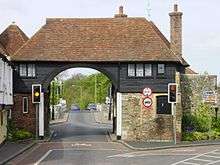
The Guildhall, in the town square, was built in 1579. Work in 1812 encased the building in yellow brick, this was removed 100 years later in 1912, when the south-west wing was also added. Further alterations were undertaken later in the 20th century. It contains antique panelling and paintings, particularly within the council chamber. It is a Grade II* listed building.[34] It includes a stained glass window in the courtroom, showing Queen Elizabeth I arriving at Sandown Gate in 1573, which was added in 1906.[35] The courtroom is still used regularly for civic functions, such as 'Mayor-making', and available to hire as a wedding venue.[36][37]
The Admiral Owen is a pub in a two-storey, 15th century timber-framed building. It was refronted in the 18th century, but this work preserved the overhang of its first floor on a Bressummer and massive corner post with three brackets.[38] The nearby Crispin Inn was originally called the Crispin and Crispianus. It has similar timber framing and was built in the 16th century.[39] Across the road on the quay is the Bell Hotel, which underwent major rebuilding in the 18th and 19th centuries. There has been a Bell Inn on the quay since the 14th century.[40]
The three pubs cluster around The Barbican which was built in the late 14th century. It consists of 2 round towers, with chequered work of stone and flints. A narrow road passes between the towers with a semi-circular timber barrel roof over it. A small 2-storeyed 20th-century house built on to north side of the north west tower was occupied by the toll collector for the bridge.[41] The Sandwich Toll Bridge was built in 1773 of Portland stone with a Dutch type timber raised platform which was replaced in 1892 with an iron swing bridge.[42]
Windmills
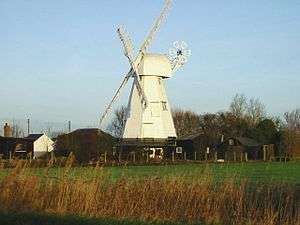
Sandwich has had at least eight windmills over the centuries, the earliest reference to a mill being dated 1608.[43] Two windmills were marked by Hasted at the New Cut on the Stour estuary. They were most likely pumping mills associated with the saltworks there in the late eighteenth century.[43]
The White Mill is the only survivor. It was built in 1760 and worked by wind until 1929, then by engine until 1957. Today it has been restored and is a heritage and folk museum. The Black Mill was a smock mill which burnt down circa 1910.[44] There was also a post mill which stood near the Black Mill, and was worked in conjunction with it.[44] A smock mill on the Millwall was also known as the Town Mill. It was burnt down. Another mill of unknown type is known to have stood on the Millwall.[44] A sixth windmill stood to the north west of Sandwich, and west of the railway. It formed a group of three with the Black Mill and its neighbour.[44]
Museum
Sandwich Guildhall Museum houses original copies of Magna Carta and the Charter of the Forest from 1300.[21] Other exhibits explore the history of Sandwich and include Roman relics, famous figures and a wide variety of medieval and modern artefacts. Admission is free and visitors can view the Guildhall Tudor courtroom.[45]
The museum was fully refurbished in 2017.[46]
Sandwich Guildhall Archives adjoins the museum and holds material related to the history of Sandwich. This includes maps and plans, photographs, burial information, postcards, newspapers, books, personal collections as well as research relating to Sandwich up to the present day. Access is open to the public by appointment.[22]
Transport
The town is served by Sandwich railway station. It was formerly also served by Sandwich Road railway station on the East Kent Light Railway.
Sandwich has been bypassed by the A256 road, which connects Thanet to Dover. It is reached from Canterbury by the A257, which joins the A256 at Sandwich.[47]
Stagecoach in East Kent operate local buses to other major towns in East Kent. Sandwich is on the Diamond network also including Canterbury, Dover and Deal. The Diamond route from Sandwich is 13 and 14 to Canterbury, where one can transfer to the rest of The Diamond or other routes, or to Deal, where one can transfer on to the rest of The Diamond. Local bus routes 87,88 between Dover and Ramsgate and route 89 between Dover and Canterbury also serve the town.
Religious sites
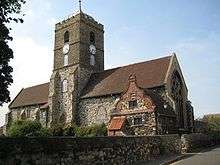
St Bartholomew's Chapel was restored and enlarged by Sir George Gilbert Scott in the 19th century.[48] Nearby were two religious almshouses: St Bart's Hospital dates back to around 1190, and St Thomas's Hospital was built in the 14th century and named in honour of St Thomas Becket.[49]
The Church of St Peter includes some evidence of early Norman work, but was rebuilt in the early 13th century. In 1661 the top of the central tower collapsed, destroying the south aisle.[50] The Anglican parish church is St. Clement, which has a tower dating from the latter half of the 12th century; the rest of the church is from the 12th and 14th centuries.[51] St Mary's Church also has Norman features and was built on the site of a convent founded by Domne Eafe, cousin to King Ecgberht of Kent.[52]
Sport
Sandwich has two world-class golf courses, Royal St George's which hosts The Open Championship approximately every 10 years,[53] and Prince's which hosted The Open Championship in 1932,[54] and is currently an Open Championship Final Qualifying course. The Open Championship returned to Sandwich in 2011 and will be returning to the town in 2020.[55]
Education
Within the immediate area of Sandwich there are four schools: Sandwich Infants (for children aged 4 to 8), Sandwich Juniors (8 to 11), Sir Roger Manwood's School (11 to 18) and Sandwich Technology School (11 to 18).
Culture
The town's connection with the food item of the same name is that John Montagu, 4th Earl of Sandwich, who lived in the 18th century, allegedly invented it. As the story goes, he was an avid gambler, and since he often did not have time to sit for a meal due to his gambling habits, he would order his valet to bring him meat tucked between two pieces of bread. Because Montagu was the Earl of Sandwich, others began to order "the same as Sandwich!"[56] However, the exact circumstances of the invention are still the subject of debate. A rumour in a contemporary travel book called Tour to London by Pierre Jean Grosley (although not confirmed) formed the popular myth that bread and meat sustained Lord Sandwich at the gambling table.[57] An alternative suggestion by Sandwich's biographer, N. A. M. Rodger, is that due to Sandwich's commitments to the navy, to politics and the arts, the first sandwich is more likely to have been consumed at his desk, a practice perpetuated in offices ever since.[58]
Sandwich Festival
The town of Sandwich has an annual festival period towards the end of August[59] when a number of events are staged. During Sandwich festivals of the past there have been European markets, motorcycle meets, an illuminated boat parade or dressed ship parade on The Quay, a street Barn Dance, various concerts (both classical and modern pop/rock), Simultaneous Chess Tournament with Grand Master John Emms and a vintage Car Show. The festival usually lasts for eight days.
Newspapers
Sandwich has two paid-for newspapers, the Deal and Sandwich Express (published by Kent Regional News and Media) and the East Kent Mercury (published by the KM Group). Free newspapers for the town include the Dover Extra, part of the KM Group; and yoursandwich, part of KOS Media.
Radio
The local radio station for Sandwich is KMFM Shepway and White Cliffs Country, although the town has good coverage of KMFM Thanet. Sandwich is also served by the county-wide stations Heart, Gold and BBC Radio Kent. Sandwich is also covered by Podcasting service Dover Community Radio [60] who cover Dover District with local podcasts on their website. They hope to create a district-wide internet based radio station in the future leading to a community licence. Academy FM Thanet can also be well received in the Sandwich area.
Trivia

There is a nearby hamlet to the south called Ham. A fingerpost three miles from Sandwich in the hamlet of West Street points towards both Ham and Sandwich, thus reading "Ham Sandwich".
References
- "Archived copy" (PDF). Archived from the original (PDF) on 6 January 2014. Retrieved 5 January 2014.CS1 maint: archived copy as title (link)
-
- "It had just closed up, and now it was preserved, two miles from the sea, in its own rich silt", as Paul Theroux remarked in The Kingdom by the Sea, 1983:33.
- Eilert Ekwall, The Concise Oxford Dictionary of English Place-names, p.404.
- "Dig uncovers Roman invasion coast". BBC News Online. 2 October 2008.
- "Roman invasion beach found in Kent: Archaeologists unearth landing point of legions – only now it's two miles from the coast". The Independent. 2 October 2008.
- Gillingham, John (2000). Richard I. p. 251. ISBN 0300094043.
- "Key Magna Carta Battles, 1214–1267". Magna Carta 800th Committee. Archived from the original on 7 July 2014. Retrieved 2 July 2013.
- See the history of elephants in Europe
- Major, Alan (1994). Hidden Kent. Countryside Books. ISBN 1-85306-295-2.
- Historic England. "Fisher Gate (1069601)". National Heritage List for England. Retrieved 2 April 2010.
- Historic England. "The Barbican (1069655)". National Heritage List for England. Retrieved 2 April 2010.
- Palmer, Alan; Palmer, Veronica (1992). The Chronology of British History. London: Century Ltd. pp. 125–128. ISBN 0-7126-5616-2.
- F.W. Cross, "History of the Walloon and Huguenot Church at Canterbury." In: Publications of the Huguenot Society of London, 15 (1898), p. 13.
- M. Backhouse, The Flemish and Walloon Communities at Sandwich during the Reign of Elizabeth I (1561-1603), Brussels: Paleis der Academieën, 1995, pp. 32-34.
- "Sandwich Town Council". Civic Heraldry of England.
- "Thomas Paine". Sandwich People & History. Open Sandwich. Retrieved 2 April 2010.
- Historic England. "20 and 22 New Street (1069586)". National Heritage List for England. Retrieved 2 April 2010.
- Historic England. "The Salutation (1069643)". National Heritage List for England. Retrieved 2 April 2010.
- "Sandwich History: Introduction". Open Sandwich — History of Sandwich.
- "Jean Alys Campbell-Harris, Baroness Trumpington". The Peerage. Retrieved 3 April 2010.
- "How a long-lost Magna Carta was found in a British town". Retrieved 20 February 2015.
- "Sandwich Town Council: The Guildhall Museum". www.sandwichtowncouncil.gov.uk. Retrieved 31 October 2019.
- "Sandwich Town Council: List of Councillors". www.sandwichtowncouncil.gov.uk. Retrieved 31 October 2019.
- "Thanet South: New Boundaries Calculation". Electoral Calculus. Archived from the original on 16 July 2011. Retrieved 6 April 2010.
- "British towns twinned with French towns [via WaybackMachine.com]". Archant Community Media Ltd. Archived from the original on 5 July 2013. Retrieved 20 July 2013.
- "National Commission for Decentralised cooperation". Délégation pour l’Action Extérieure des Collectivités Territoriales (Ministère des Affaires étrangères) (in French). Archived from the original on 27 November 2013. Retrieved 26 December 2013.
- Sandwich Bay Bird Observatory Trust Archived 18 March 2010 at the Wayback Machine
- "Gazen Salts". Breathing Spaces. BBC. Archived from the original on 11 May 2011. Retrieved 2 April 2010.
- Pfizer Reorganization Could Bring Jobs To Kalamazoo Archived 21 October 2013 at the Wayback Machine, WWMT.com, 18 June 2007
- "Pfizer to close UK research site". BBC News. 1 February 2011.
- "Pfizer site in Sandwich set to retain 650 jobs". BBC News. 4 November 2011. Retrieved 20 December 2012.
- "University of Kent to consider Pfizer proposal". BBC News. 3 February 2011.
- "New enterprise zones", UK Government, 17 August 2011
- Historic England. "The Guildhall (1069731)". National Heritage List for England. Retrieved 2 April 2010.
- "Sandwich Guildhall". Studies of Sandwich. Archived from the original on 7 August 2008. Retrieved 2 April 2010.
- "Sandwich Town Council: Meetings and Civic Functions". www.sandwichtowncouncil.gov.uk. Retrieved 31 October 2019.
- "Weddings at the Guildhall Wedding Venue, Sandwich, Kent". www.sandwichweddings.co.uk. Retrieved 31 October 2019.
- Historic England. "The Admiral Owen Public House (1069656)". National Heritage List for England. Retrieved 3 April 2010.
- Historic England. "The Crispin Inn (1343736)". National Heritage List for England. Retrieved 3 April 2010.
- Historic England. "Bell Hotel (1069666)". National Heritage List for England. Retrieved 3 April 2010.
- Historic England. "The Barbican (1069655)". National Heritage List for England. Retrieved 3 April 2010.
- Historic England. "Toll Bridge (1343735)". National Heritage List for England. Retrieved 3 April 2010.
- West, Jenny (1973). The Windmills of Kent. London: Charles Skilton Ltd. pp. 68–71. ISBN 0-284-98534-1.
- Coles Finch, William (1933). Watermills and Windmills. London: C W Daniel Company. pp. 271–72.
- "Sandwich Guildhall Museum". Sandwich Guildhall Museum. Retrieved 31 October 2019.
- "Museum reopens after £100K refurbishment". Kent Online. 3 May 2017. Retrieved 31 October 2019.
- Sandwich, Kent – OpenStreetMap (Map). Cartography by OpenStreetMap contributors. OpenStreetMap. Retrieved 9 April 2012.
- Historic England. "St Bartholomews Chapel (1343722)". National Heritage List for England. Retrieved 2 April 2010.
- "The ancient hospitals of Sandwich". Open Sandwich. Retrieved 2 April 2010.
- Historic England (2011). "Church of St Peter, Sandwich (1343813)". National Heritage List for England. Retrieved 24 April 2011.
- Historic England. "Church of St Clement (1343695)". National Heritage List for England. Retrieved 2 April 2010.
- Historic England. "St Mary's Church (1069541)". National Heritage List for England. Retrieved 2 April 2010.
- "Open Championship 2011". Royal St George's Golf Club. Retrieved 3 April 2010.
- "Open Championship 1932". Princes Golf Club. Archived from the original on 4 April 2010. Retrieved 3 April 2010.
- "Archived copy". Archived from the original on 7 November 2017. Retrieved 3 November 2017.CS1 maint: archived copy as title (link)
- Stradley, Linda (20 May 2015). "Sandwich History". What's Cooking America.
- "Hexmaster's Factoids: Sandwich". www.faktoider.nu.
- Rodger, N.A.M, The Insatiable Earl: A Life of John Montagu, Fourth Earl of Sandwich (London: Harper Collins, 1993), ISBN 0-00-215784-5, ISBN 978-0-00-215784-1
- "Sandwich Festival".
- "DCR Local Radio for Dover, Deal, Sandwich and the surrounding areas". www.dcrfm.co.uk.
External links

- Discover Sandwich, Kent, UK including a brief history of the Town
